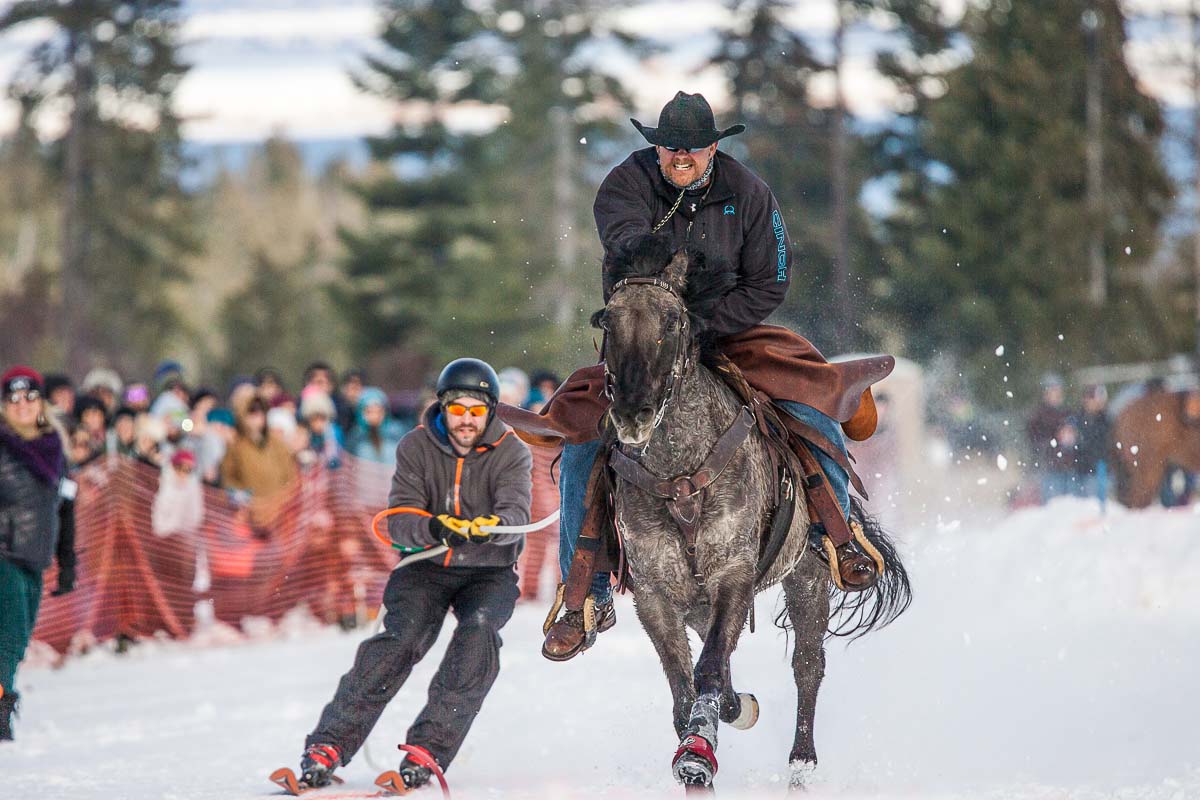How to Photograph a Skijoring Event
Rick Sheremeta uses the Tamron SP 24-70mm F/2.8 VC and SP 150-600mm VC lenses to capture this high-action hybrid sport.
By Jenn Gidman
Images by Rick Sheremeta
Where there's snow, there's usually skijoring—a winter sport that involves a brave competitor on skis tethered to sled dogs, a vehicle, or (in the case of two annual events photographed by Rick Sheremeta in Whitefish and Lakeside, Montana) horses. For more than a decade, the Whitefish event has been held in January as part of its winter carnival, with preliminary races held on Fridays and the main competitions rolling into Saturday and Sunday.
"This year, we lucked out," Rick says. "It was relatively warm and sunny, which is much better photography-wise. I've shot it on overcast days and it doesn't do it justice. I had my winter hat and jacket on, but my jacket was open and I just had a pair of liner gloves on (I probably didn't even need those)."
The Whitefish competition takes place on a U-shaped track. "The participants start on one end, head down to make a turn, then come back parallel to the starting direction," Rick explains. "They also have jumps and stubby things sticking out of the ground called gates that they have to ski around or they'll get penalized. Of course, because it's not a perfectly straight course, there's more of a chance for spills. It can be pretty jaw-dropping when you see a full-bore horse take a flop."
Two of the lenses Rick used on his latest adrenaline-packed adventure: the Tamron SP 24-70mm F/2.8 VC and SP 150-600mm VC lenses. "The 150-600 works great to isolate the riders and skijorers from the background because of the shallow depth-of-field you can get," he notes. "The 24-70, meanwhile, is ideal when I can get closer to the action."
Rick's approach when he first arrives at the skijoring site is to get the lay of the land. "I try to previsualize different vantage points and what I'm going to get in terms of the action and background," he says. "The biggest challenge is dealing with distracting background elements, whether it's spectators, other photographers, a building or the railroad track right next to the Whitefish course, for example, where freight trains go by every 20 minutes or so, and I try to get as much of the mountains in the background as I can."
Things out here are pretty loose in terms of crowd control, "There's only a snow fence that separates the spectators from the track, but it's really close to the action—it's literally almost on the track itself," Rick explains. "It helps that I usually have media credentials and can get inside the fence, so I have more latitude to walk around freely (though I have to try to not get trampled by the competitors)."
Read on to see how Rick captured these images from his day at Whitefish.
Manage your light.
It's important to know from which direction the sunlight is coming. In general, I want the sun either on the side or in back of me. Very rarely do I shoot toward the sun, because then I'll just get shadows on my subject matter and/or lens flare
When it's nice and sunny like it was this year, with uniform lighting, I'll use evaluative metering. I'll usually take a few test shots, pointing my camera in a couple of different directions, with an occasional glance at my histogram. If I think it's a little overexposed, I'll set the exposure compensation down a stop; if I think it's a little underexposed because the background is dominating the exposure as opposed to the snow, I'll increase the exposure compensation by a stop. And sometimes I'll just shoot it at zero.
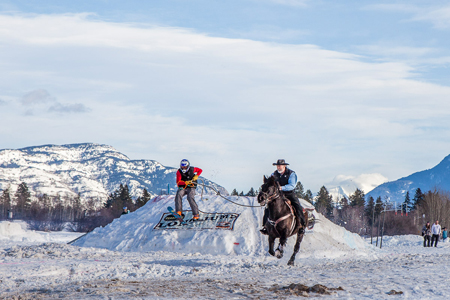
24-70mm (at 70mm), F/6.3, 1/1250th sec., ISO 200
Capture the action.
That's why you're there! I almost always shoot a race like this in Shutter Priority mode and try to use at least a 1/2000th of a second shutter speed. I also set my autofocus to AI Servo (Canon) or Continuous/AF-C (Nikon). Once I lock focus on the subject, it tracks it as the subject is moving. The best shots are when the skier goes over the jump. I start shooting in burst mode as soon as I first see the horse's nose coming before the jump.
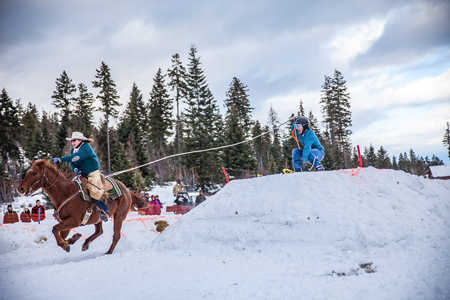
24-70mm (55mm), F/2.8, 1/1600th sec., ISO 200
It's a little more predictable when the racers are coming right down the straightaway toward the finish line. The horse is at a full gallop, and the skier is trying to get over that last jump. The woman in this photo is probably really digging her spurs into the side of that pony. There was a lot of hootin' and hollerin' and yayin' while they raced to the finish.
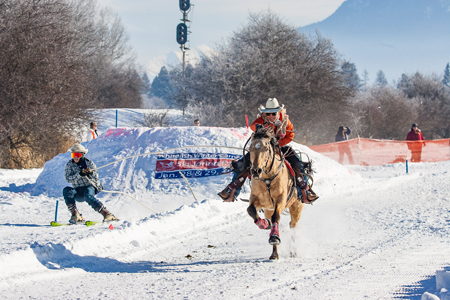
150-600mm (at 165mm), F/7.1, 1/2500th sec., ISO 400
Focus on the horse and rider.
Your focus should be on the horse, and the rider, because that's the first thing you see. I've unintentionally taken a few photos in which the skier is in focus and the rider and horse aren't, and it's just doesn't look right.
This is also a way to ensure that the rider's facial expression is in focus. Those expressions give you a sense of how intense and exhilarating the sport is. This type of skijoring shot is actually the most difficult to capture, I find, because the competitors need to be coming almost straight at you to achieve a decent image. I'm fairly close to the path of the horse in this image, so if the horse slipped, I could've been in trouble. That's one of the caveats of doing something like this—but it's also how you end up with the best pictures.
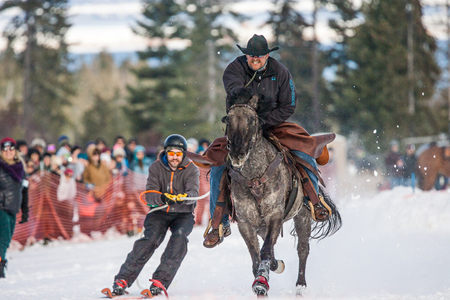
150-600mm (at 450mm), F/6.3, 1/2000th sec., ISO 200
Take advantage of cropping.
One of the biggest problems at a crowded event like this are distracting background elements. That's why for this image I made sure to crop out some extraneous stuff on the left side of the frame in my favorite post capture editing software - Lightroom. By doing that, it helped me focus in more on the action and get rid of distracting spectators. The compression capabilities of that 150-600 also came into play here: The mountain in the background was probably 10 miles away, but with the compression, it looked so close that it appeared there was a forest in close proximity.
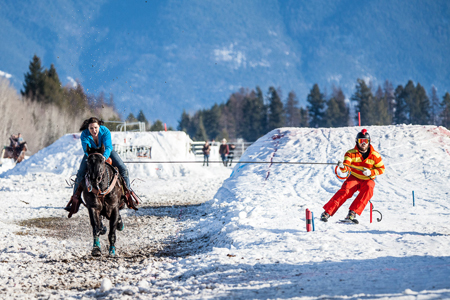
150-600mm (at 275mm), F5.6, 1/1250th sec., ISO 400
Slow down for some detail images.
I always try to look for interesting things going on no matter what event I'm shooting—and it doesn't always have to be the action itself. At skijoring events, they usually allow the riders and skiers to walk the course beforehand to get a handle on things. Usually when the riders review the course, they strut around on their horses and show off their stuff. Some of the riders are real hams!
That's what this rider was doing, and I thought it was a neat picture because it shows him in his cowboy getup, complete with chaps and hat. A lot of skijoring competitors don't dress up like this anymore, so it's fun to see it when they do. I did some more cropping on this photo. I wanted to isolate the rider, but there was another rider close by and you could see part of that horse and stirrups in the photo. I was able to crop those extraneous elements out and focus on my main subject.
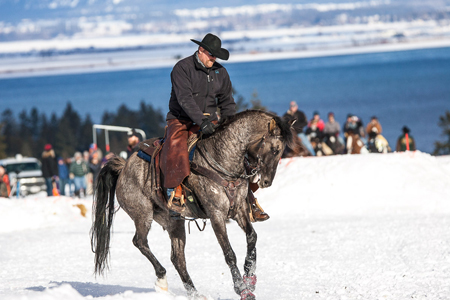
150-600mm (at 310mm), F/5.6, 1/2000th sec., ISO 200
To see more of Rick and Dody Sheremeta's work, go to Facebook
